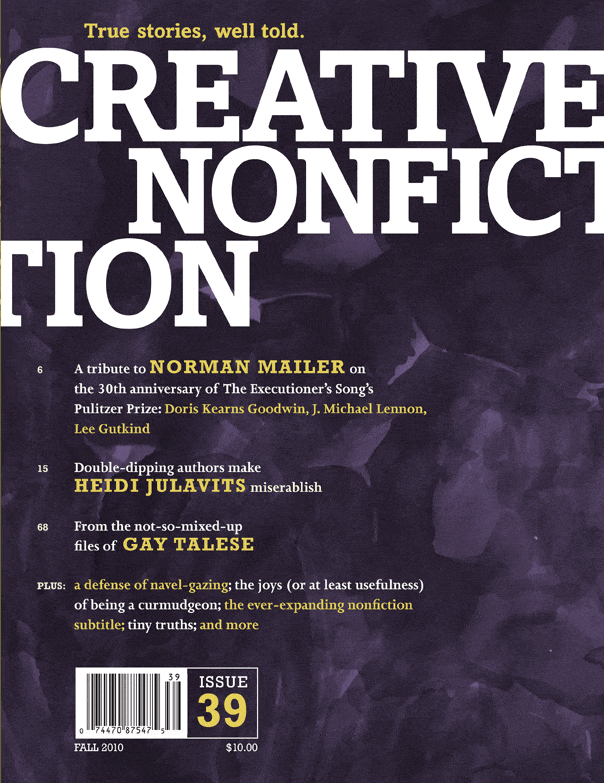Issue 39 / Fall 2010

39 / Unthemed
We pay tribute to Mailer and Talese, feature new essays from emerging and veteran writers, and more
This issue of Creative Nonfiction pays tribute to Norman Mailer and Gay Talese, pioneers of the genre, and features new essays by new writers (and a couple veterans). To round out the issue, there’s a miserablish columnist, a defense of curmudgeonry and a bold argument in favor of navel-gazing.
Already a subscriber?
Read this issue nowTable of Contents
What’s the Story #39
There’s a lot of handwringing, recently, about how tough the publishing industry has become, how much change there is—which, of course, there is, though I suspect we’re romanticizing “the good old days.”ENCOUNTER: Norman Mailer
What I appreciated most about Norman Mailer, as a writer and a person, was how genuine, honest and available (although often overzealous) he was. He didn’t hide who he was or how he felt or what he thought.The Earthy, Unforgettable Mailer
Norman was more generous to his fellow scribes than any writer I have ever known, sharing his time, advice and the puzzles of his craft. His biographer, Mike Lennon, has uncovered more than 50,000 letters Norman wrote to fellow writers and friends, more than 5,000 of them to young writers.A new (vaguely unpleasant) type of literary déjà vu
As (I suspect) is the case for many people my age who suffer from chronic absentmindedness and a prodigious sleeping pill habit, my reading experiences are often tinged with déjà vu.What’s So Awful about Navel-gazing?
People who read my memoir often want to know whether I’m healed. This question always terrifies me. I didn’t know I needed to be healed, but leaving that aside for the moment, it’s still a question that stymies me: “After writing X, did you feel healed?”The Heart
Two troubled souls who—despite their love—simply would not, and maybe could not, be soothedFragile
Mutare General Hospital was beautiful once, with whitewashed stucco arches curving over open verandas. Now the roofs rust to a deep red as the walls yellow. Grass fills the pavement’s cracks by the weathered guard station.Why I Run
I notice the words right away. They float against the beige brick wall. I’m struck by the specificity of the phrase and the way it rolls off my tongue: “Fatigue Detection Capability.End of the Line
I was born in Baltimore on Sept. 11, 1955. I am white, a male and a lapsed Irish Catholic. I love my family, immediate and extended, but keep my feelings too much of a secret.Final Cascade
When I was 20, my mom began calling to talk to me about a dying man neither she nor I ever knew—the identical twin of a close family friend. She called repeatedly, crying, and described to me the slow erosion of his body.A Connoisseur of Narrative Forms
Mailer always described himself as a novelist, but his nonfiction was equally (if not more) distinguished.Apology
“Your honor, as you know, I have already pled guilty to the charges against me, but I appreciate this opportunity to provide some background for my actions, so that they may be judged within the fuller context I will here provide in explaining that on the night of April 24, after a long shift not selling cars at Ford West, a dealership in Bellflower, I drove home through a slight drizzle to San Pedro, stopping by The Port Hole, a small bar just up the street from this courthouse, where, between approximately midnight and 1 a.m.,Beds
The first was a bassinet. I don’t remember what it was made of; I think it was one of those big white baskets with wheels.The Writer as Curmudgeon
The essay feasts on doubt, self-doubt, contradiction and paradox. Nowhere is this more striking than in essays written in opposition to a seemingly unchallengeable good. Examples of the tradition include Joyce Carol Oates’ “Against Nature,” Susan Sontag’s “Against Interpretation,” Witold Gombrowicz’s “AgainstPoets,” Laura Kipnis’ “Against Love” and (dare I include) my own “Against Joie de Vivre.”Gay Talese: WRITER AT WORK
This issue examines Gay Talese’s approach to composition. The dapper Talese, who turned 78 this year, is the author of “Honor Thy Father,” “Thy Neighbor’s Wife” and other classic works of creative nonfiction.Eight Questions You Would Ask If I Told You My Name
An imaginary—but also all-too-real—conversationMeeting House
The Live Oak Meeting House, where Friends gather each Sunday to sit in silence until the spirit moves them, wasn’t entirely quiet, at first. The child in the pew in front of me whispered as she nuzzled against her grandmother’s neck.The Woman
On the outskirts of my Tanti Marie’s village, where the village met the wild forests, there was a proper little cemetery, with marble cross tombstones alongside wooden ones, enclosed by a wrought-iron fence.Foot-long subs
"As a publisher, there’s one moment I dread in the list-planning meetings where editors present their upcoming titles to colleagues. It’s when someone says, 'We need to talk about the sub.'"Jerald Walker: On Guarding Against An Over-Active Imagination
An interview with Jerald Walker, writer of "The Heart"On Guarding Against an Over-Active Imagination
An interview with Jerald Walker, writer of essay "The Heart"
